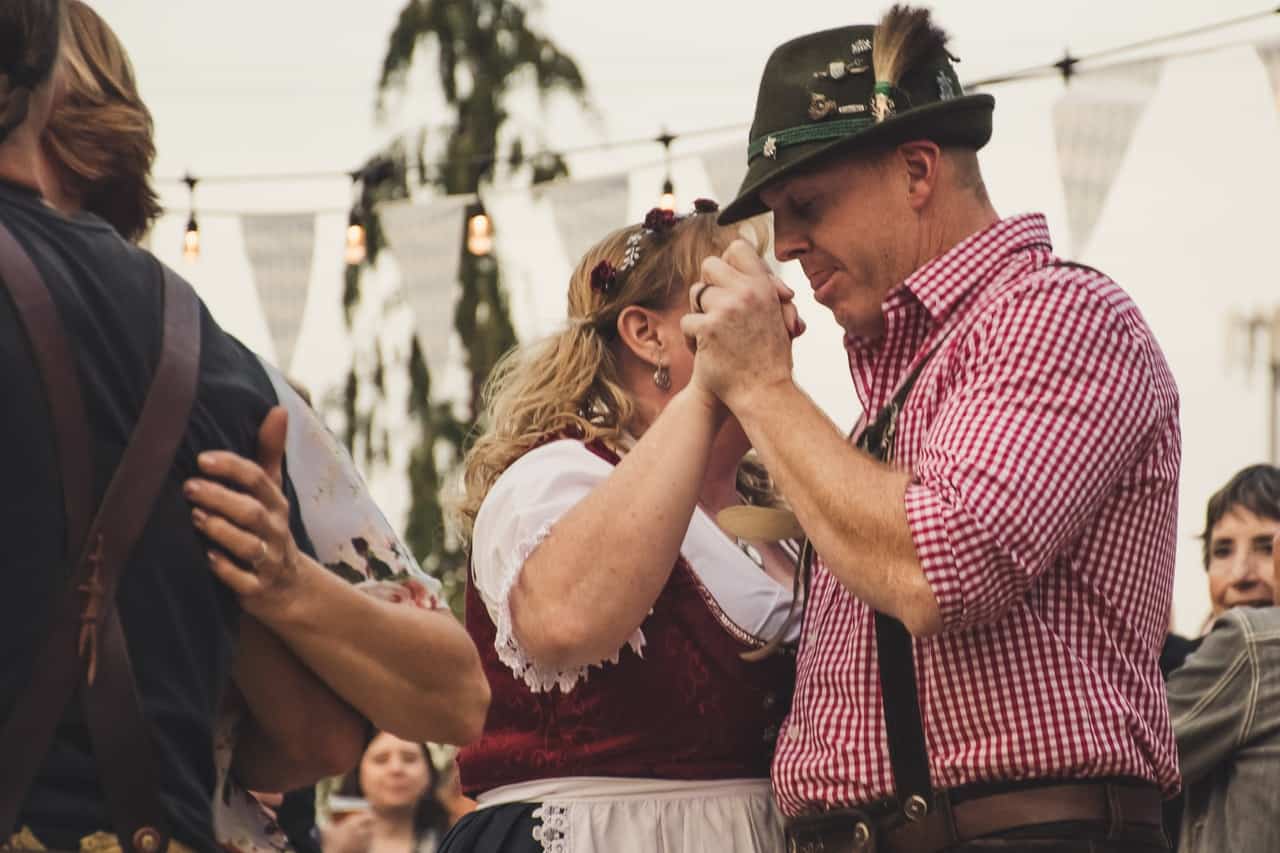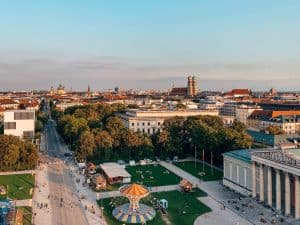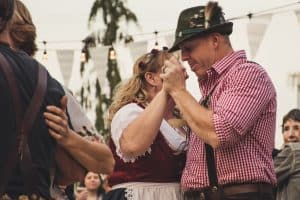Last Updated on October 10, 2024 by Aswetravel
Oktoberfest In Munich – As you walk along the streets of Munich this week, you could be forgiven for thinking that you’d stepped back in time. Men are decked out in lederhosen and checked shirts, women are showing off their curves in traditional Dirndl dresses and everyone is slurping frothy beer and enjoying huge platters of meat. It can only mean one thing – Oktoberfest is back in the town! The world’s biggest beer festival invites locals and visitors to eat, drink and be merry together, and 6 million people flock to Munich city each year to do just that. The Oktoberfest is a traditional German beer festival that takes place in Munich, Bavaria. It is the world’s largest fair and one of the most popular festivals in Germany. The event lasts for 16 days from late September to early October and attracts an estimated 6 million people each year.
It was first held on 15 October 1810 by Prince-Bishop Maximilian von Montfort as part of his attempt to revive the medieval tradition of the Märztage. These were originally intended to celebrate the end of winter and the start of spring but had become occasions when many Germans drank themselves into oblivion. In 1811 the prince bishop decided to hold a more formal celebration at which he would serve food and wine to all comers. This became known as the Festaktion am Königsplatz and it has been celebrated every year since then. It is now a public holiday in Bavaria and is also celebrated in Austria, Switzerland, Liechtenstein, Luxembourg, Belgium, France, Italy, Spain, Portugal, Poland, Romania, Hungary, Croatia, Serbia, Montenegro, Macedonia, Slovenia, Czech Republic, Slovakia, Bulgaria, Estonia, Latvia, Lithuania, Russia, Ukraine, Belarus, Kazakhstan, Kyrgyzstan, Tajikistan, Turkmenistan, Uzbekistan, Armenia, Azerbaijan, Georgia, Israel, Palestine, Lebanon, Syria, Iran and various communities across the United States of America.
Oktoberfest In Munich
So whether you’re a first timer at Oktoberfest or looking at Munich flights and growing your mustache in preparation for next year, here are some tips for how to survive the crowds and really get into the spirit of this exuberant two-week celebration. It is held annually in Munich Bavaria, Germany. Locally, it is called d’Wiesn, after the colloquial name for the fairgrounds, Theresienwiese. In 1994, this longstanding schedule was modified in response to German reunification. In 1812, the festival was moved to inside the city walls. The new location was chosen because it had a central location and could be easily defended against possible attacks. A temporary wooden pavilion was built on the site, which became known as the Festhalle. The festival continued to grow, attracting about 200,000 people each day. By 1813, the number of attendees reached 500,000.
In 1814, the festival was interrupted by Napoleon Bonaparte’s army, who occupied Munich until 1815. After his defeat at Waterloo, he fled from France through Switzerland and then into northern Italy. He died in exile in Saint Helena in 1821. His body was returned to Paris for burial in Les Invalides. During World War II, the Festhalle was used as an air-raid shelter by the Luftwaffe. On September 1, 1944, American forces captured the area. They renamed the Festhalle “The Great Hall”and turned it into a military hospital. In 1949, the first official Oktoberfest took place in Munich. Since then, the event has grown enormously, becoming the largest beer festival in the world with over six million people attending each year. The original festival lasted three days, but now lasts five. Today, the festival takes place every year between late September and early October. The original festival consisted of two separate events: the opening ceremony, when the mayor would open the gates of the old city wall to allow access to the public; and the main event, which started on the Friday night and ended on Sunday morning. This changed in 1990, when the opening ceremony was replaced by a parade. The parade is still held today, and features floats, marching bands, and local politicians.
Today, the festival runs for five full days, starting on the Saturday afternoon and ending on the Monday evening. Each day starts with a different theme, such as ‘Family Day’, ‘Women’s Day’, or ‘Children’s Day’. These themes are usually represented by special activities and entertainment. On the Saturday, there is also a parade, where participants dress up as characters from fairy tales and other stories. There are many parades throughout the festival, including those themed around Santa Claus, Father Christmas, Mother Christmas, and the Easter Bunny. On the first day, the opening ceremony begins at noon. At 12:30pm, the Mayor opens the gates of the old city wall, allowing the public to enter the inner city. At 2pm, the Mayor officially welcomes everyone to the Oktoberfest. At 3pm, the traditional glass of stein is passed around among the crowd. It is customary to drink one stein per person.
Munich Oktoberfest Tents
Oktoberfest takes place across 14 different tents, which spring up across the city in the week before the festival kicks off. The tents vary in size but all house the familiar rows of beer-stained wooden benches, with colorful bunting draped across the high ceilings. The first beer of Oktoberfest is always poured in the largest tent Schottenhamel – it houses a massive 10,000 people, so expect the cheers to be deafening. Backpackers tend to head to the Hofbräu tent, where you’ll predictably find young American travelers enjoying liter on liter of the beer that they’re banned from buying at home. If you’re in Munich with the family, head to the Augustiner Festhalle tent for a calmer and cozier atmosphere and to enjoy beer from more modestly-sized wooden kegs. Tuesdays is family day and this friendly tent offers great-value meals for kids and adults between 12 and 6pm – for an afternoon of German celebrity-watching check out the famous Hippodrum tent – it’s a favorite of Boris Becker’s.
Oktoberfest In Munich Accommodation
If you’re already in Munich, you’ll know that the city is crammed to capacity – booking a hotel room in advance is an absolute must and even the city’s temporary campsites become full weeks before the festival begins. In the city center expect to pay hiked-up ‘festival prices’, particularly in the area around the hub of the action in the Wiesn. If you don’t mind a short train journey into Munich, try looking at rooms in the neighboring towns of Nürnberg, Augsburg, Ingolstadt, Landshut and Rosenheim.
Oktoberfest In Munich
With so many revelers crammed into one city, it’s often hard to find at seat at Oktoberfest. But the one rule of the festival is this – no seat, no beer. Do a bit of pre-planning before you leave for the airport and note down all the tents and events that you’d like to see. On weekdays make sure you get to your chosen tent by 2pm at the absolute latest and before midday on weekends. There are outside places to sit across the city, but the cold weather and lack of brass bands playing sing-a-longs may dampen your festival spirit somewhat.
Oktoberfest Beer Halls
Hofbräuhaus am Platzl – One of the most famous beer halls, it operates the second largest tent at the Oktoberfest, one of Munich’s most famous tourist attractions for beer and food. The beer tents are called “Bierzelte”, and attract millions of tourists worldwide during the two weeks of festivities. The Oktoberfest finishes on the first Sunday of October. Augustiner Bräu, Paulaner, Hacker-Pschorr, Hofbräu, Löwenbräu, Spaten-Franziskaner-Bräu are a few of the most popular beers.
Living In Kreuzberg Berlin
German Dining Etiquette
Garmisch-Partenkirchen

Oktoberfest Food
The Schottenhamel Tent where the Lord Mayor of Munich taps the first keg every year officially starting off the 5th Season. Outdoor tables in the biergärtens surrounding or adjacent to the big tents are not reserved, and are on a first-come, first-serve basis. It’s always polite to ask first – “Ist hier Platz frei?” – when joining a partially -occupied table. Be sure to say “Prost!” when raising your beer on high, saluting your neighbors at the table, and don’t forget to return their greeting as well. Outdoors as well as in, waiters are assigned tables and only your wait person may take your order. Otherwise, go to the self-service counter for beer or food. You may bring your own food to the outdoor biergärtens, but not indoors. For a fraction of the price, you can buy bigger and better pretzels (Brezn), radish bunches, sliced meats, cheese, sausages, roasted chicken or ribs at area shops or at the stands outside the Oktoberfest grounds for outdoor consumption. However, beverages for adults must be purchased at the venue. Bottles for infants and small children are allowed.
Another aspect of Oktoberfest is the “Olde Wies’n,” a separate area south of the Riesenrad (huge Ferris wheel area where admission is charged). Established a few years ago, the Old Wies’n has proven to be a hit. Its nostalgic tone harkens back to O’fests of yesteryear with old-fashioned rides and entertainment that reflect a simpler time, when the fest was still Bavaria’s own national event during the austere post-war years of the 1920s, 50s, and early 60s. Many traditional dishes grace the menus, the tents are less packed, and service is friendly. The beer is even served in old-fashioned, salt-glazed grey clay mugs rather than modern-day glass steins. Indoors, table reservations are valid, anyone can plop down where space is available for guests without reservations must move on. Entire tables seat 10 people, and are usually sold out by June or July. The cost to reserve a table is 2 pints of beer and half a chicken, or the equivalent, per person. Go to the Betriebsbüro or business office in the tent to see if reservations are still available or to buy coupons. Each brewery issues beer and chicken coupons, including a separate tip fee, which can be used in any tent where its beer is served. Some breweries, like Spaten, have two, three, or more tents. Coupons do save visitors cash, but are not interchangeable, meaning a Schottenhamel tent coupon is not valid elsewhere. Unused coupons might be redeemable at some of the establishments after Oktoberfest, but be sure to ask ahead.



